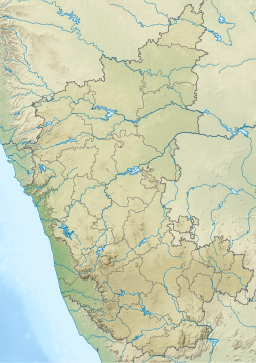
Karnataka is a state in the southwestern region of India. It was formed as Mysore State on 1 November 1956, with the passage of the States Reorganisation Act, and renamed Karnataka in 1973. The state is bordered by the Lakshadweep Sea to the west, Goa to the northwest, Maharashtra to the north, Telangana to the northeast, Andhra Pradesh to the east, Tamil Nadu to the southeast, and Kerala to the southwest. With 61,130,704 inhabitants at the 2011 census, Karnataka is the eighth-largest state by population, comprising 31 districts. With 15,257,000 residents, the state capital Bangalore is the largest city of Karnataka.

Mysore, officially Mysuru, is the second-most populous city in the southern Indian state of Karnataka. It is the headquarters of Mysore district and Mysore division. As the traditional seat of the Wadiyar dynasty, the city functioned as the capital of the Kingdom of Mysore for almost six centuries. Known for its heritage structures, palaces, and its culture, Mysore has been called the "City of Palaces", the "Heritage City", and the "Cultural Capital of Karnataka". It is one of the cleanest cities in India according to the Swachh Survekshan.
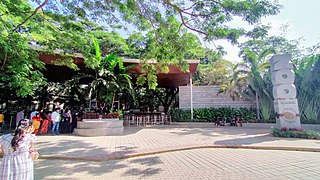
Mysore Zoo, officially known as Sri Chamarajendra Zoological Gardens, is a composite of zoological gardens and animal park located in the southern Indian city of Mysore, Karnataka. Stretching across a 157-acre (64 ha)-expanse and situated at about 700 metres from Mysore Palace, it is the oldest zoo in India and one of the oldest in the world. One of the most popular zoos in India and one of the city's most popular attractions, it is home to a wide range of over 168 species.

Lalbagh Botanical Garden or simply Lalbagh, is an botanical garden in Bangalore, India, with an over 200-year history. First planned and laid out during the dalavaiship of Hyder Ali, the garden was later managed under numerous British Superintendents before Indian Independence. It was responsible for the introduction and propagation of numerous ornamental plants as well as those of economic value. It also served a social function as a park and recreational space, with a central glass house dating from 1890 which was used for flower shows. In modern times, it hosts two flower shows coinciding with the week of Republic Day and Independence Day. As an urban green space along with Cubbon Park, it is also home to numerous wild species of birds and other wildlife. The garden also has a lake adjoining a large rock on which a watchtower had been constructed during the reign of Kempegowda II.

Mysore district, officially Mysuru district, is an administrative district located in the southern part of the state of Karnataka, India. It is the administrative headquarters of Mysore division. Chamarajanagar District was carved out of the original larger Mysore District in the year 1998. The district is bounded by Chamrajanagar district to the southeast, Mandya district to the east and northeast, Kerala state to the south, Kodagu district to the west, and Hassan district to the north.
The flora and fauna of Chennai are the plants and animals in Chennai, India.
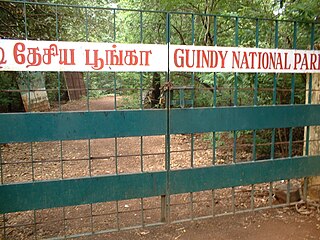
Guindy National Park is a protected area, located in Chennai, India. Spread across 2.70 km2 (1.04 sq mi), it is one of the smallest National Parks in India and one of the few national parks situated inside a metropolitan area. The park is an extension of the grounds surrounding Raj Bhavan, the official residence of the Governor of Tamil Nadu and encloses forests, scrub lands, lakes and streams.
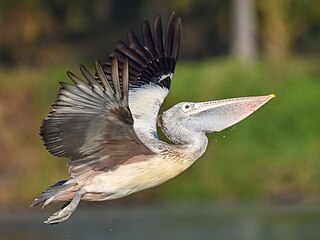
Ranganathittu Bird Sanctuary, is a bird sanctuary in the Mandya District of Karnataka in India. It is the largest bird sanctuary in the state, 40 acres (16 ha) in area, and comprises six islets on the banks of the Kaveri river. The sanctuary has been designated on 15 February 2022 as a protected Ramsar site since 2022.

Shimoga district, officially known as Shivamogga district, is a district in the Karnataka state of India. A major part of Shimoga district lies in the Malnad region or the Sahyadri. Shimoga city is its administrative centre. Jog Falls view point is a major tourist attraction. As of 2011 Shimoga district has a population of 17,52,753. There are seven taluks: Soraba, Sagara, Hosanagar, Shimoga, Shikaripura, Thirthahalli, and Bhadravathi. Channagiri and Honnali were part of Shimoga district until 1997 when they became part of the newly formed Davanagere district.

Kayyara Kinhanna Rai was an Indian independence activist, author, poet, journalist, teacher and farmer.

The state of Karnataka in South India has a rich diversity of flora and fauna. It has a recorded forest area of 38,720 km2 which constitutes 55 of the geographical area of the state. These forests support 25% of the elephant population and 20% of the tiger population of India. Many regions of Karnataka are still unexplored and new species of flora and fauna are still found. The mountains of the Western Ghats in the western region of Karnataka are a biodiversity hotspot. Two sub-clusters of the Western Ghats, Talacauvery and Kudremukh, are on a tentative list of sites that could be designated as World Heritage Sites by UNESCO. The Bandipur and Nagarahole national parks which fall outside these subclusters were included in the Nilgiri biosphere reserve in 1986, a UNESCO designation. In the Biligiriranga Hills the Eastern Ghats meet the Western Ghats. The state bird and state animal of Karnataka are Indian roller and the Indian elephant. The state tree and state flower are sandalwood and lotus. Karnataka is home to 524 tigers.
Karnataka has been a leading state in electronic communications, in India, since the start of first private radio station in Mysore, in 1935.

Byadagi chilli is a variety of chilli mainly grown in the Indian state of Karnataka. It is named after the town of Byadgi which is located in the Haveri district of Karnataka. It is sometimes written as Bedgi in some supermarkets and grocery stores in India. The business involving Byadagi chillis has the second-largest turnover among all chilli varieties of India. An oil, oleoresin, extracted from these chillies is used in the preparation of nail polish and lipstick. Byadagi chilli is also known for its deep red colour; it is less spicy and is used in many food preparations of South India. Byadagi chilli has been accorded Geographical Indication (GI) in February 2011. Its GI tag is 129.

Tholkappia Poonga or Adyar Eco Park is an ecological park set up by the Government of Tamil Nadu in the Adyar estuary area of Chennai, India. According to the government, the project, conceived based on the master plan for the restoration of the vegetation of the freshwater ecosystems of the Coromandel Coast, especially the fragile ecosystem of the Adyar estuary and creek, was expected to cost around ₹ 1,000 million which will include the beautification of 358 acres of land. The park's ecosystem consists of tropical dense evergreen forest, predominantly comprising trees and shrubs that have thick dark green foliage throughout the year, with over 160 woody species, and comprises six vegetative elements such as trees, shrubs, lianas, epiphytes, herbs and tuberous species. The park was opened to public by Chief Minister M. Karunanidhi on 22 January 2011 and named after the renowned Tamil scholar Tholkappiar. About 65 percent of the park is covered by water and artefacts and signages. In the first 2 months of its inauguration, nearly 4,000 children from several schools in the city and the nearby Kancheepuram and Tiruvallur districts have visited the park to learn about wetland conservation, eco-restoration and water management. While the first phase of the ecopark covered about 4.16 acres of CRZ-III area, the entire area covered under the second phase falls under this category.
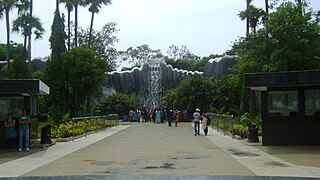
Arignar Anna Zoological Park, also known as the Vandalur Zoo, is a zoological garden located in Vandalur, Chennai, India, about 31 kilometres (19 mi) from the Chennai Central and 15 kilometres (9.3 mi) from Chennai Airport. Established in 1855, it is the second public zoo in India. It is affiliated with the Central Zoo Authority of India. Spread over an area of 602 hectares, including a 92.45-hectare (228.4-acre) rescue and rehabilitation centre. The zoo houses 2,553 species of flora and fauna across 1,265 acres (512 ha). As of 2012 the park houses around 1,500 wild species, including 46 endangered species, in its 160 enclosures. As of 2010, there were about 47 species of mammals, 63 species of birds, 31 species of reptiles, 5 species of amphibians, 28 species of fishes, and 10 species of insects in the park. The park, with an objective to be a repository of the state's fauna, is credited with being the second wildlife sanctuary in Tamil Nadu after Mudumalai National Park.

Arjuna was an Asian elephant who, from 2012 to 2019, was the lead elephant and the carrier of the Golden Howdah at the Mysore Dasara. He was named after Arjuna, the third of the Pandava brothers from the Hindu epic Mahabharatha. Arjuna was part of a Karnataka Forest Department to tackle wild elephants across western Ghats of Karnataka and also operated in many states for capturing wild elephants. Arjuna died in combat on 4 December 2023.
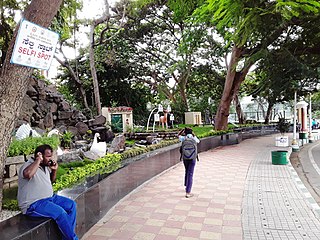
Jayachamarajendra Circle or Jayachamarajendra Wadiyar Circle, formerly known as Harding Circle or Arugatu is an intersection of six major roads in Mysore, Karnataka state, India.
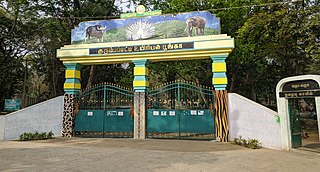
The Kurumbapatti Zoological Park is a second largest zoo in Tamil Nadu next to Arignar Anna Zoological Park, situated in the foothills of the Shervaroyan Hills, 10 km from Salem, Tamil Nadu, India. It was set up in 1981 as a small museum and was later extended to 69 Ha. The zoo houses many species of wildlife, with monkeys as the major attraction, and is in the vicinity of reserve forest, permitting visitors the opportunity to also experience the flora and fauna there. The park has a gentle topography, areas of bamboo and woodland and semi-perennial streams. Facilities include a children's playground area.

